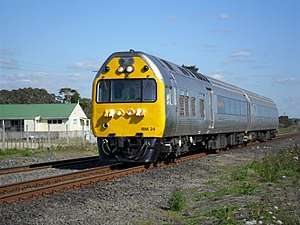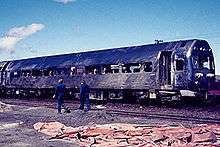NZR RM class (Silver Fern)
The NZR RM class Silver Fern was a class of rail motor in New Zealand. The three air-conditioned and sound-proofed 723-kW[1] 96-seater diesel-electric twin-set railcars were built by Kawasaki and Toshiba, trading as Nissho Iwai Company of Japan.[4] New Zealand Railways classed the railcars RM, like all other railcars. All three are now withdrawn from service, awaiting a decision on their future.[5]
| New Zealand RM class Silver Fern | |
|---|---|
 Silver Fern railcar RM24 near Papakura, Auckland on 9 September 2011, the opening day of the Rugby World Cup 2011. | |
| In service | 1972 - present |
| Manufacturer | Kawasaki and Toshiba, trading as Nissho-Iwai Company of Japan |
| Constructed | 1972 |
| Entered service | 1972 - 2019 |
| Number built | 3 |
| Fleet numbers | RM 1, 2, 3 (original) RM 18, 24, 30 (TMS)[1] |
| Capacity | 96 |
| Operator(s) | New Zealand Railways Department (1972 - 1982) New Zealand Railways Corporation (1982 - 1990) New Zealand Rail Limited (1990 - 1995) Tranz Rail (1995 - 2002) Auckland Regional Transport Authority (2002 - 2009)[2] KiwiRail (2008 - present) Dunedin Railways (2012 - present) |
| Line(s) served | North Island Main Trunk Palmerston North - Gisborne Line East Coast Main Trunk (former) Rotorua Branch (former) |
| Specifications | |
| Train length | 47.4 metres (155 ft 6 in) total[1] |
| Car length | 22.86 metres (75 ft 0 in)[3] |
| Width | 2.74 metres (9 ft 0 in)[3] |
| Maximum speed | 120 km/h (75 mph)[1] |
| Weight | 107 tonnes (105 long tons; 118 short tons) |
| Prime mover(s) | Caterpillar D398TA |
| Power output | 670 kW (900 hp) |
| Track gauge | 3 ft 6 in (1,067 mm) |
History
The railcars are most famous for their service on the eponymous North Island Main Trunk daylight passenger train between Auckland and Wellington between Sunday 14 December 1972 and Sunday 8 December 1991.
Built by Kawasaki and Toshiba (trading as Nissho Iwai), the Silver Ferns were introduced in 1972 to encourage passengers back to rail transport due to competition from air and road transport. The class was named the "Silver Ferns" (a national symbol of New Zealand) because of their exterior was made of corrugated stainless steel, like the overnight "Silver Star" carriage train, and replaced the three 82-seater Blue Streak railcars.
In December 1991 the Silver Fern was replaced by the Overlander carriage train. The railcars were transferred to two newly introduced services: the Kaimai Express between Auckland and Tauranga and the Geyserland Express between Auckland and Rotorua. In 2000, a third service was added, the Waikato Connection between Auckland and Hamilton. All three services ceased on 7 October 2001.
From 2002 two of the class were employed on Auckland Regional Transport Authority (ARTA) commuter services between Auckland and Pukekohe.[2] The services were operated by Veolia Auckland as part of their contract with ARTA, with ARTA leasing the units from Tranz Scenic, later KiwiRail.
This lease expired in 2009 and the units were replaced by additional carriage services. This freed the units for charter and other services, such as KiwiRail's "Explore by Rail" specials. In 2010 a major refurbishment of the units commenced in Wellington to extend their services, with the programme completed by mid-2011. Proposals existed for the units to be employed on a revived Waikato Connection service,[2] but this fell through late in 2011.
In service
The Silver Fern offered airline-style service on board. Drinks, snacks and the morning paper were supplied to passengers. From 1972 to 1988 there was a lunch stop at Taihape for services in both directions. That was replaced by airline-style meals heated on board, and Taihape railway station dining room was closed, the station later being demolished and replaced by a shelter.
Charter use
Following a refurbishment of RM30, Tranz Scenic operated various excursion services under their "Explore by Rail" brand. The first of these excursion services was the "Silver Fern - Otaki and Beyond Tour" which commenced on 19 September 2009. This saw RM 30 travelling from Wellington to Feilding and return on 5 Saturdays between September and December 2009. Since the Otaki and Beyond Tour, RM 30 has been used on other Explore by Rail services including:
- A special Valentine's Day trip in February 2010 from Wellington to Chateau Tongariro (via National Park) for an overnight stay.
- East Coast Explorer: Ran during Easter weekend 2010. This saw RM30 leave Wellington on Friday heading to Napier, then up to Gisborne on the Saturday and return on Sunday. The service will then return to Wellington on Monday.
- Hawkes Bay Weekender: Operates every second weekend of each month between May and October 2010. This service departs Wellington and travels up to Napier on the Saturday and returns to Wellington on the Sunday.
- ANZAC Day - National Park Tour: A special ANZAC weekend service where travellers will go from Wellington to Chateau Tongariro (via National Park) on Saturday. On the Sunday travellers will leave Chateau Tongariro for Waiouru where they will be taken to the Queen Elizabeth II Army Memorial Museum where they will attend an ANZAC service followed by a tour of the museum before heading back to Wellington.
After a recent petition by the Campaign for Better Transport which received around 11,500 signatures to start a Waikato rail service between Hamilton and Auckland (like the Waikato Connection which ceased in 2001), it looked likely that RM 18 and 24 will be used to provide this service, yet late in 2011 the councils involved voted against the Waikato Connection reinstatement based on financial and operational grounds.
In October 2012, RM24 was leased to Dunedin Railways for trips between Dunedin and Waitati and charter trains between Dunedin and Christchurch, Dunedin and Invercargill and also Christchurch to Arthurs Pass. In October 2013 during the NZ Rail 150 celebrations, it was used on shuttle trains between Ferrymead Heritage Park and Lyttelton, Christchurch and Rolleston, Christchurch and Rangiora plus an evening run from Christchurch to Springfield and return. RM30 has recently returned to service after a second refurbishment due to the withdrawals of the 56-foot 'AO' carriages.
Upgrades
During October 2008, RM30 was taken to the Wellington Passenger Depot for extensive refurbishment. This work included the stripping of the interior in the passenger saloons, allowing corrosion repairs to be carried out. New thermal, noise deadening insulation was added.
The interiors now have new carpet and refurbished seats. Each seat bay now also has a power socket for passenger use. Tables have been added with mahogany veneer, echoing the new timber-featured ceiling with ash and mahogany from sustainable forestry. Lighting was upgraded to modern energy-efficient standards, including individual reading lights in the new coat racks. Also fitted were large, triple glazed windows, to give a more panoramic view. No significant mechanical work is believed to have been undertaken. The two other railcars were refurbished in 2009.
In February 2015, RM30 was refurbished for a second time. New seats, a new engine and the power bogie from RM 18 were fitted.
Accidents

On 18 August 1981, half of the first and second sets derailed and rolled north of Waiouru when the northbound service was descending curves. Passengers reported that the railcar had been travelling quickly over this section of the journey and the speed around curves just before the derailment had been concerning. The subsequent enquiry found that many of the speed restriction boards for the curves in the area were missing or misleading; a full audit of speed restrictions across the entire rail network was one of the enquiry outcomes. Four people were killed and another 16 injured.[6] The railcars were replaced by the "Blue Fern" on Wednesdays for three years until May 1984, to allow the two remaining railcar sets to be serviced while the damaged set was being repaired.
In 1989 and again in 1990 the Blue Fern train ran instead of railcars after Silver Fern railcar RM1 was involved in an accident.[7]
Withdrawal
In 2019, the two remaining serviceable Silver Ferns were withdrawn from service by KiwiRail. They are currently in storage awaiting a decision about their fate.[5]
See also
References
- McClare 1980, p. 26.
- "Waikato Rail Business Case" (PDF). Waikato Regional Council. 7 May 2009. Retrieved 3 March 2019.
- Pierre 1981, p. 170.
- KiwiRail 2011, p. 55.
- "Railfan". 26 (1). Triple M Publications. Summer 2020. ISSN 1173-2229. Cite journal requires
|journal=(help) - Nancy Swarbrick. 'Railway accidents - Types of accidents', Te Ara - the Encyclopedia of New Zealand, updated 26-Nov-10, retrieved 4 January 2011.
- "New Zealand Railway Observer". 46 (4). New Zealand Railway and Locomotive Society. Summer 1989–90: 165. ISSN 0028-8624. Cite journal requires
|journal=(help)CS1 maint: date format (link)
Bibliography
- McClare, E J (1980). New Zealand Railway Diesels. Wellington, New Zealand: Southern Press. ISBN 9780907769286.
- Bill Pierre (1981). North Island Main Trunk: An Illustrated History. A.H. & A.W. Reed. ISBN 0-589-01316-5.
- KiwiRail Locomotive and Rolling Stock Register - 2011. Mosgiel, New Zealand: Triple M Productions. 2011. ISBN 978-0-9582072-2-5.